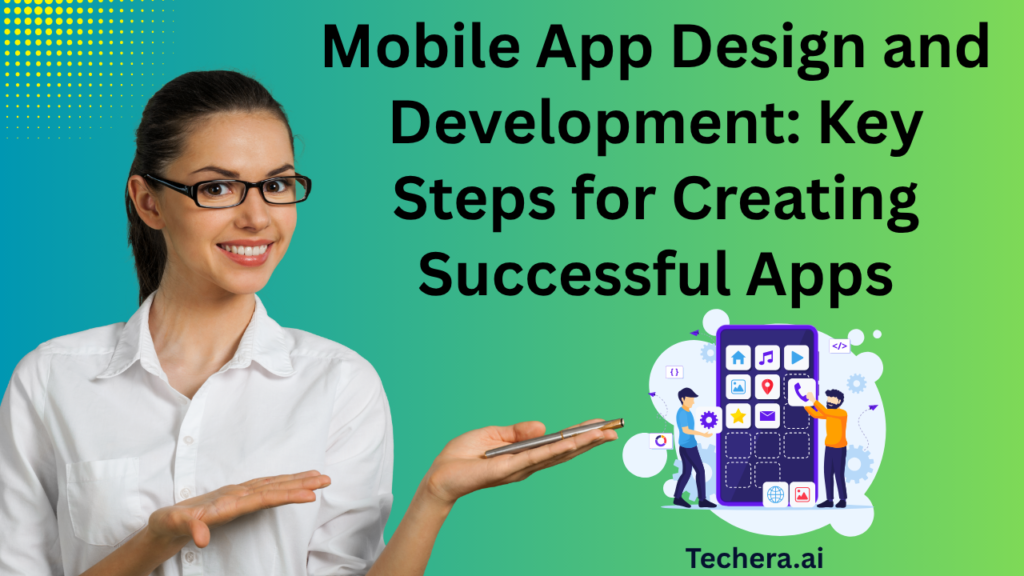
Discover the essential steps for effective mobile app design and development, from planning to launch. Learn how a strong mobile app design and development process leads to successful and engaging applications.
Introduction
In today’s smartphone-driven world, mobile apps are at the heart of digital transformation. From online shopping to fitness tracking, apps simplify life, connect people, and help businesses thrive. But not every app achieves success — only those built with a strong foundation in mobile app design and development stand out.
Let’s explore the key steps to creating successful mobile apps — from idea to launch and beyond.
Understanding the Mobile App Ecosystem
What Defines a Successful Mobile App
A successful app offers value, works seamlessly, and provides an engaging experience. It’s not just about coding — it’s about solving a real problem efficiently.
Current Trends in Mobile App Design and Development
The app world evolves fast. AI integration, dark mode mobile app design and development, voice search, and 5G-powered features are shaping the future. Staying updated with trends ensures your app remains competitive.
Choosing the Right Platform
Selecting between iOS, Android, or cross-platform frameworks (like Flutter or React Native) depends on your audience, budget, and timeline. Each has its pros and trade-offs.
Step 1 – Defining Your App Idea
Conducting Market Research

Every great app starts with a solid idea.
Ask yourself: What problem will my app solve? and Who will use it?
Study existing competitors. Check app reviews and identify gaps you can fill. Use tools like Google Trends, Sensor Tower, or App Annie to validate demand.
Understanding Your Target Audience
Knowing your users’ habits, preferences, and pain points helps design a better experience. Create user personas to keep mobile app design and development user-focused.
Step 2 – Planning and Strategy
Before diving into design, strategize.
Setting Clear Goals
Define measurable objectives — downloads, engagement rate, revenue model, etc.
A clear vision helps align your team’s efforts.
Choosing the Right App Type
- Native Apps: Best performance but higher cost.
- Hybrid Apps: Cost-effective and faster to build.
- Web Apps: Accessible via browsers; great for simpler use cases.
Creating a Development Roadmap
A roadmap outlines milestones, responsibilities, and timelines. Tools like Jira, Asana, or Trello help organize tasks efficiently.
Step 3 – Wireframing and Prototyping
Wireframing helps visualize your app’s structure. It’s like drawing your home’s blueprint before building it.
Tools for Wireframing
Use platforms like Figma, Sketch, or Adobe XD to create clickable prototypes and refine your concept before coding begins.
Building Prototypes
Share prototypes with potential users and stakeholders to collect feedback early and avoid costly redesigns later.
Step 4 – UI/UX Design
Design is where your idea takes life.
Principles of Effective UI/UX
Keep mobile app design and development intuitive, visually appealing, and user-focused.
Follow a minimalist approach — less clutter, more clarity.
Creating a User-Centered Design
Empathize with users. Ensure buttons are easily tappable, text is readable, and navigation feels natural.
Best Practices for App Usability
- Maintain consistency in design elements.
- Optimize for both light and dark modes.
- Ensure accessibility for users with disabilities.
Step 5 – Choosing the Right Tech Stack
The right technology stack ensures performance and scalability.
Front-end vs Back-end
Front-end handles user interaction (UI), while the back-end manages data and server-side logic.
Common Frameworks
- iOS: Swift, Objective-C
- Android: Kotlin, Java
- Cross-platform: Flutter, React Native, Xamarin
Integrating APIs
APIs enable advanced features like payments, location tracking, and push notifications, enhancing user experience.
Step 6 – App Development Process
Agile Methodology
Agilemobile app design and development divides work into sprints — promoting flexibility, testing, and continuous feedback.
Collaboration Between Teams

Designers, developers, and marketers must collaborate from day one to ensure consistency across UI and functionality.
Testing During Development
Test features as they’re built, not just at the end. This prevents bugs from piling up.
Step 7 – Testing and Quality Assurance
Types of Testing
- Functional Testing: Checks features and workflows.
- Performance Testing: Ensures smoothness and speed.
- Security Testing: Protects user data.
Automated vs Manual Testing
Automated testing saves time, while manual testing ensures a human touch — both are essential for reliability.
Step 8 – Deployment and Launch
Preparing for Launch
Make sure your software complies with Google Play and software Store regulations. Double-check permissions, icons, and metadata.
App Store Optimization (ASO)
Optimize your title, description, and screenshots to increase discoverability — just like SEO for websites.
Marketing Strategies
Use pre-launch teasers, social media campaigns, and influencer marketing to build hype before release.
Step 9 – Post-Launch Support and Maintenance
Monitoring Performance
Track metrics like crash rates, user retention, and session times. Tools like Firebase Analytics or Mixpanel help analyze data.
Regular Updates
Constantly improve your app with bug fixes, security patches, and new features to retain users.
Also read The Ultimate Guide to Mobile App Design and Development
Common Mistakes to Avoid
- Neglecting user feedback
- Overloading with features
- Ignoring app store guidelines
- Poor testing and rushed launches
Future of Mobile App Design and Development
AI and Automation
AI enhances personalization, automates tasks, and improves user experiences through predictive analytics.
AR/VR Integration
Immersive experiences in gaming, retail, and education are the next big leap.
Low-Code and No-Code Tools
Platforms like Bubble and Adalo empower non-mobile app design and development to create apps quickly.
Conclusion
Creating a successful mobile app isn’t about luck — it’s about strategy, design, and continuous improvement. By following the key steps above, from idea to post-launch, you can develop an app that stands out in a crowded market and delivers real value to users.
FAQs
1. How long does it take to develop a mobile app?
Depending on complexity, it can take anywhere from 3 months to a year.
2. What’s the best platform for startups — iOS or Android?
Start with the platform your target audience uses most. Later, expand cross-platform.
3. How can I make my app stand out?
Focus on solving a real problem, keep your design simple, and deliver excellent user experience.
4. Do I need coding skills to build an app?
Not necessarily. Low-code and no-code platforms let you build functional apps without deep coding knowledge.
5. How do I monetize my app?
Options include in-app purchases, ads, subscriptions, and premium versions.

